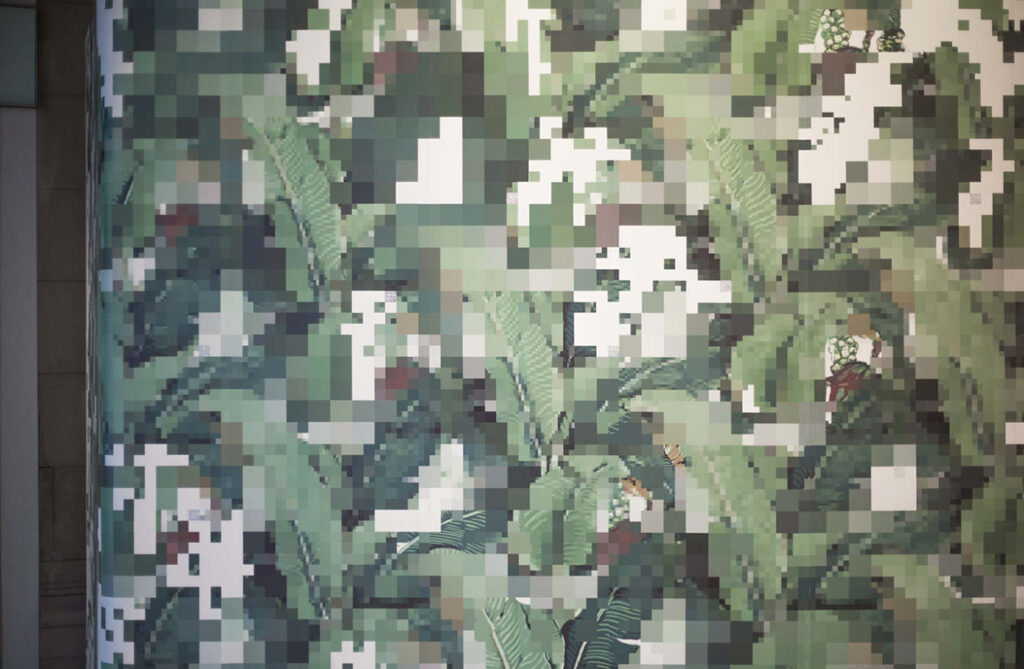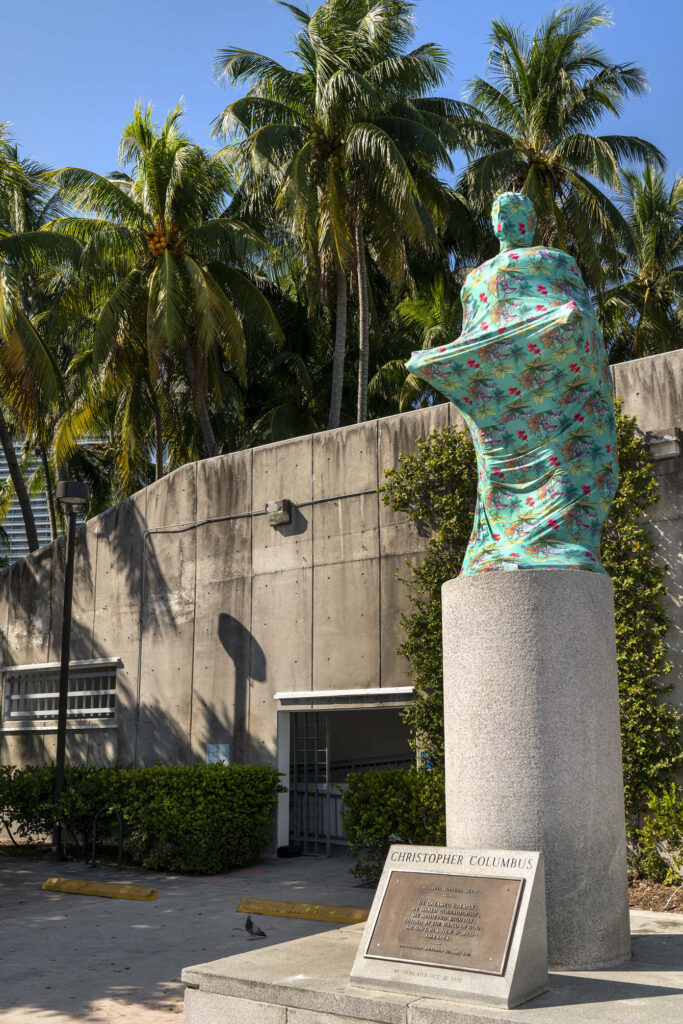
We recently spoke to the artist Joiri Minaya, and she shared with us how her work has been the result of her experience in the diaspora. Her work is like a timeline of continuous responses to herself, it feels personal, and it matures with time. She describes it as a reassertion of herself, an exercise of unlearning, decolonizing and exorcizing imposed histories, cultures and ideas, while also exploring tropical identity as product: the performance of labor, decoration, beauty, leisure, and service.
How has growing up in Dominican Republic and then moving to the United States influenced your work?
I’m very interested in how we communicate with each other. While I grew up with the opportunity to occasionally visit the US from a young age, my interest in the construct of Dominican identity and observations about the way the nation presents itself or is perceived by the outside world definitely really solidified through my experience after moving to NY as a college student in my early 20s. I was also an exchange student in Belgium for a year when I was 17, this experience also influenced my thinking and my work years later in regards to identity and it’s perception and presentation. But that experience had a scheduled ending date after which I was to come back to the DR. It was really the thought of being in a new space for an undetermined amount of time that made me think “ok I have to deal with this, I have to talk about this.” I don’t think I would be making the work I am making if I had stayed in the Dominican Republic, my work has definitely been the result of my experience in the diaspora for the last decade and the multiple points of understanding this has provided me.


Walk us through your creative process, from research to installation or performance.
It’s different for every piece, although I do read a lot and do research for most of them. I don’t know if I have a clear beginning for all of them, because many have built up on each other. Most of them are a continuation of something I have explored before. The work I was doing in Dominican Republic before coming to New York was about gender in relation to domesticity and the type of behaviors learned at home. Women upholding this idea of domesticity and patterns as they relate to societal behavior. While the ideas of gender and pattern are still present, they aren’t necessarily tied to domesticity anymore, they’re more expansive in terms of space and context. It’s more about the outside space, about cultural and physical landscapes.
There is a progression and moments of shifts in the process, but I can’t necessarily dissect an origin for all my works. What I could say is that I start by capturing some sort of image in my head of something that calls my attention, and it sometimes takes a form of a note, a sketch or taking a screenshot, a way to make it tangible and explore it further. I have a million sketches and screenshots. Once I start seeing a pattern or I see something really getting my attention, I try to put it into words and then either write or research or both. Sometimes it’s less conceptual and more gestural, or process-based: I might explore an idea through some sort of making with my hands. Collage comes up a lot in this stage, either with images or pairing and remixing my notes and texts, accumulating files in digital folders, printing things out and pairing them in physical space, perhaps even editing things together through video. Eventually when I’ve identified something of interest and worth commenting on / communicating about / sharing with the world, I then think of the form: Should this be a fixed image on the wall? Do I need audio or movement here? Should this idea be a performance? How should this be experienced? Should you use it all at once? Should you discover things and piece them out together? What does that do to the work? What does this mean to me? What does it mean to others? Sometimes I end up with multiple forms and derivations, and this is how I’ve ended up with bodies of work that are very tightly related to each other.
In your work “Redecode,” why did you end up choosing that specific interior design wallpaper from a Beverly Hills Hotel and please go into how it becomes similar to the U.S. military uniform camouflage. We find this work fascinating.
I was following the thread of tropical imagery and pattern design that is depicting an idea of tropical space in a specific way. I identified that pattern as an iconic one, seeing derivations of that pattern everywhere, which led me to research it. I realized it was a sort of origin for that aesthetic that is still identifiable and copied today. I also realized it was designed during a time when the US was present in many places in terms of military occupation. This led me to think about the disconnection between the militarized experience in tropical space and the violence that comes with it vs. the superficial decorative approach to depicting the tropical space for consumption and the process of commodifying it through these designs and trends.
The imagery present in a lot of these patterns evokes botanical illustrations, which in a way are remnants of an imperialist past, because they were used to understand new found resources centuries ago in order to control and exploit them. The idea of sabotaging that visual aesthetic to me in the form of pixilation made sense. Later when I saw the pixelated pattern, it brought me back to the militarized idea because it looked a lot like the pixilated camouflage in the US military uniform at the time.

How has Siboney influenced all of your other works, and do you see it influencing future works?
In works like Siboney, I was trying to dissect or understand how the construction of the mulatta figure in literature and visual culture was exotified in a particular way, which is not applied to the white woman or black woman in the Caribbean, and how that is idealized in relation to nature and landscape. I began to explore these ideas in an earlier performance called Canela actually, that’s where a lot of what I’ve been unpacking in a lot of subsequent works originated at. But in Siboney the ideas and their execution came together in a more cohesive way, and it was documented better. Both of these performances were very influential to works I did later, where I was taking specific aspects of them and exploring them separately.
Have you considered perhaps moving into social justice and collaborating with organizations that help women to deal with the issues your work touches? I am trying to get at the question of do you sometimes wish art was more useful?
I was a muralist with Groundswell and other organizations for a number of years, and an educator with the Romare Bearden Foundation and most recently with the Bronx Museum. It is something that isn’t visible in my artworks, but a parallel practice I’ve had is working with communities through programs like these. I’ve thought about incorporating this aspect in a more visible way into my work somehow, there’s definitely some avenues I’m exploring in regards to this.
When you get into social issues there is always a question of sustainability and how to center the community you are working with. I don’t want to fall into the formula of a lot of “social practice art” of taking photos of the community I am working with to show this beautiful thing I am doing and reproducing a savior complex.
However, I don’t think art needs to be useful, I am perfectly fine with my work not being useful. If anything, what would be important is to extend that uselessness to people who don’t have the privilege or the access to it. When art becomes utilitarian, then it has a function and its reason to exist is that function. I think it’s part of the desire of human experience to just have time and space to reflect, and I think that’s what art provides.

